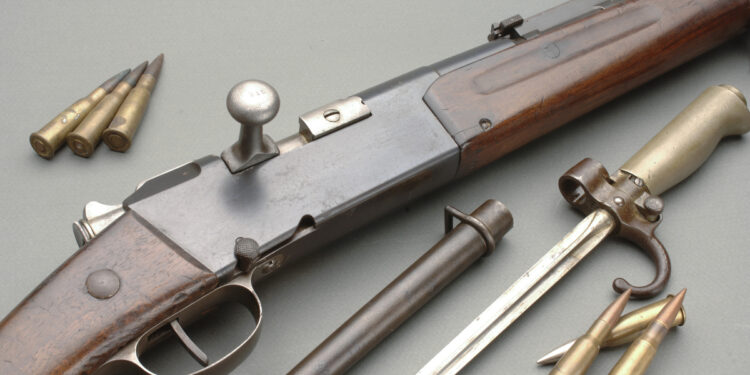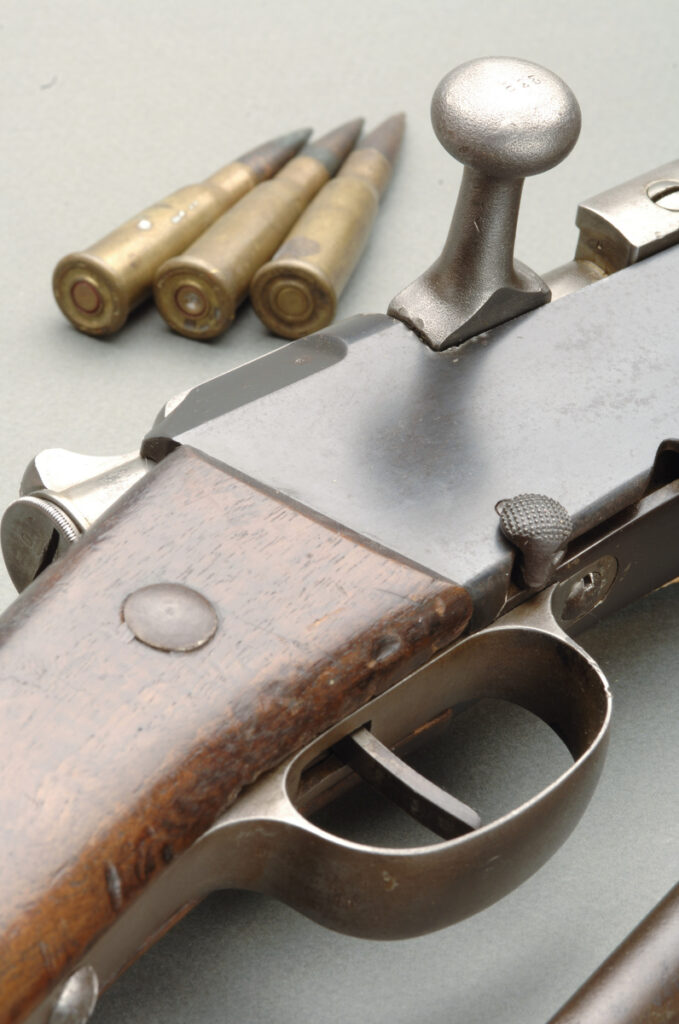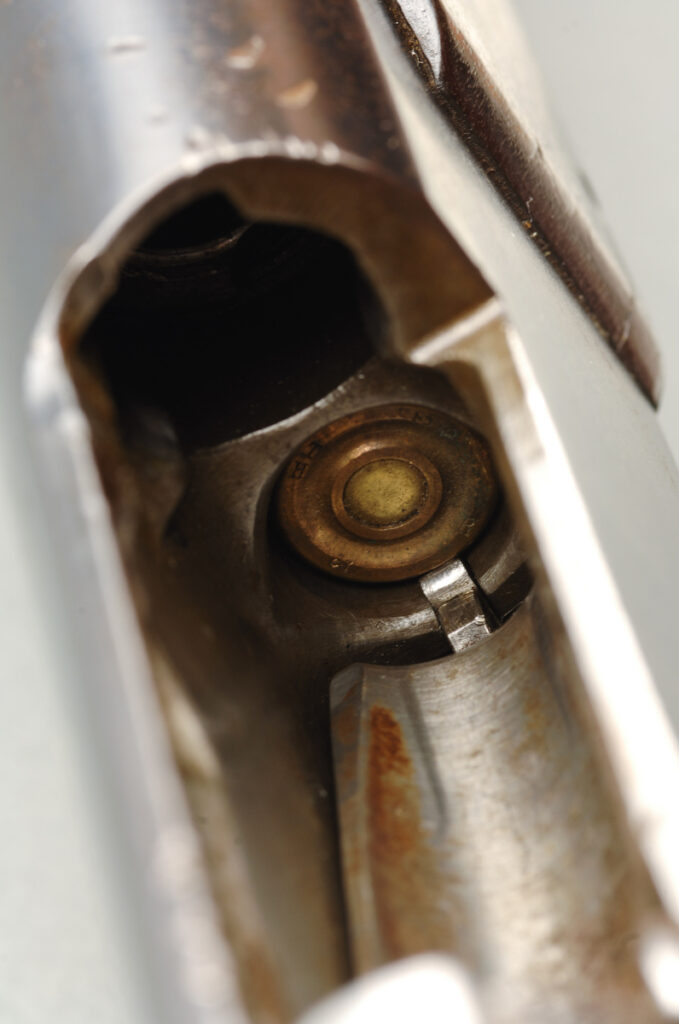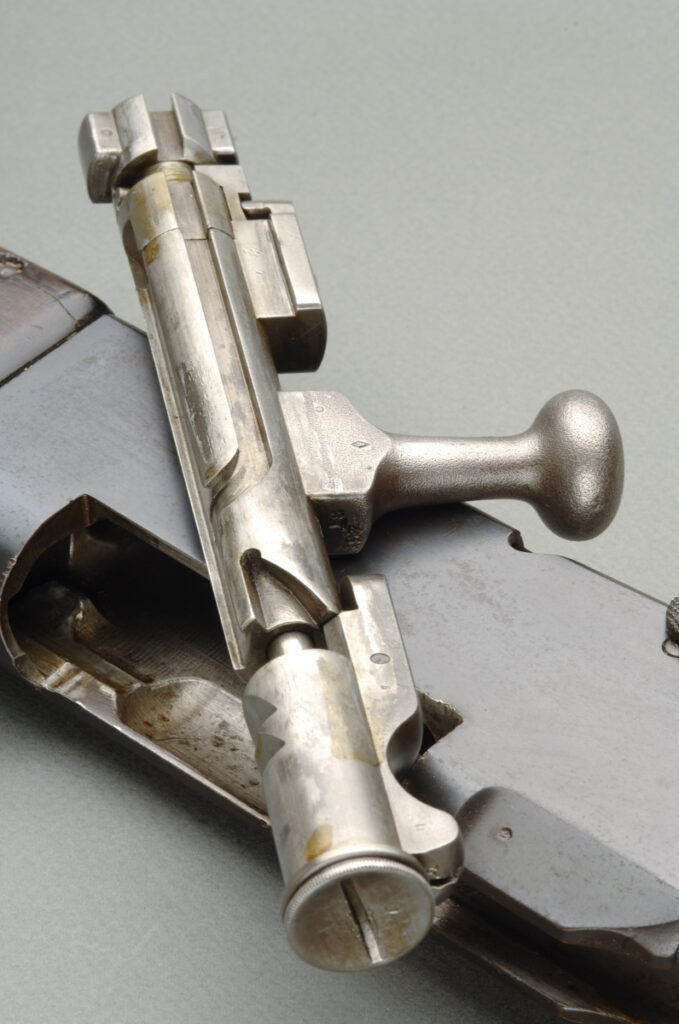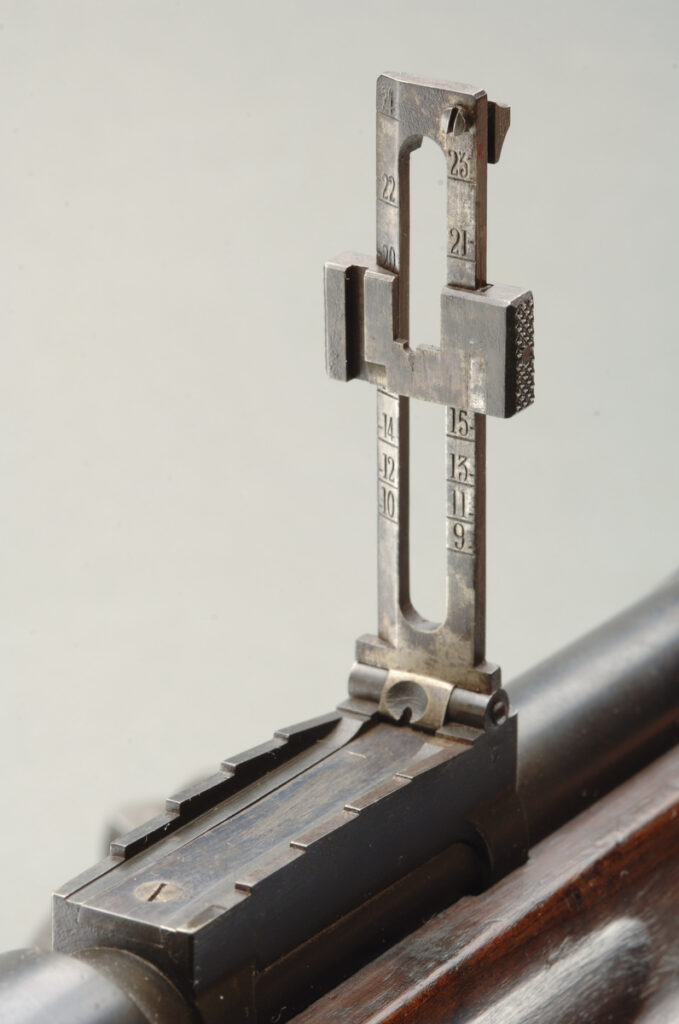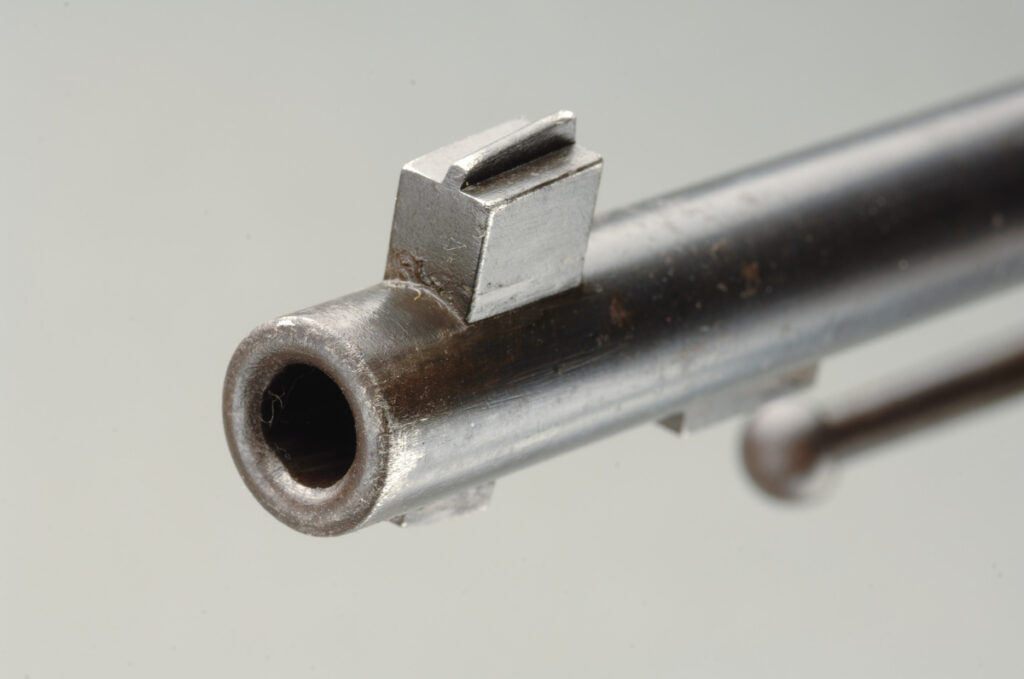by Pierangelo Tendas
Designed in 1886 and adopted the following year by the French military, the Lebel Modèle 1886 has the distinction of being both France’s first repeating service rifle, and the world’s first service rifle chambered for a smokeless round.
The defeat in the Franco-Prussian War of 1870/1871 and the subsequent fall of the Second French Empire forced the newly formed Third French Republic to re-evaluate its military needs in light of the increasing mistrust towards the neighboring and aggressive German Empire. Over a decade after the end of what was arguably the most important conflict fought in Europe between the end of the Napoleonic wars and the onset of World War I, French infantrymen were becoming seriously outgunned if compared to the German troops, which were being issued with the new Mauser Model 71-84 repeater rifle – an upgrade over the Model 1871, using an eight-shot magazine tube.
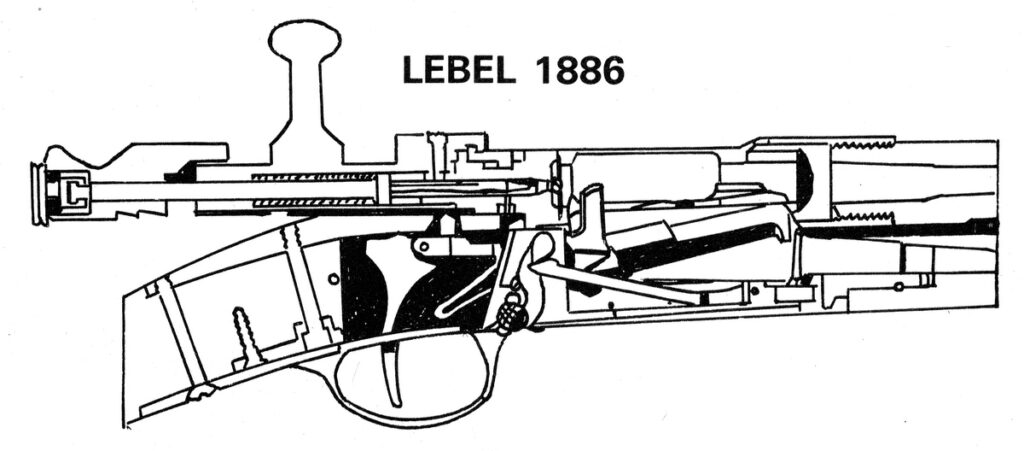
On the other hand, the French Army was still issuing the Gras Model 1874 single-shot bolt-action rifle, essentially a brass cartridge conversion of the old Chassepot design, designed by Austrian engineer Alfred Von Kropatschek and chambered for the 11×59mm rimmed black powder caliber. The French Navy had it substantially better, with the Kropatschek Model 1878 rifle, which was basically a repeater version of the 1874 feeding through a magazine tube that held eight rounds. Both would, however, go down in history as interim adoptions with the next quantum leap in individual firearm technology being just around the corner.
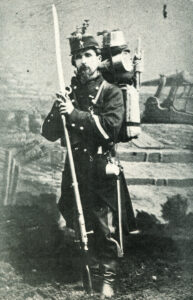
HARNESSING NEW TECHNOLOGY
Between 1882 and 1884, French chemist Paul Vieille perfected the first viable smokeless powder. His creation, named “Poudre B” (“B-powder”, where the B stood for “Blanche”, or “white”, thus meaning “white powder” in contrast to black powder), a nitrocellulose-based compound, was three times as powerful as black powder and generated a substantially lower amount of smoke and residue, keeping rifles cleaner and the rifleman’s field of view relatively unobstructed on the battlefield.
The formulation of smokeless powder, including the French Poudre B, would improve substantially in the coming years, but the French government was hell-bent on becoming an early adopter of such revolutionary military technology. The sitting French minister of war, revanchist general George Ernest Jean-Marie Boulanger, ordered the institution of a commission to design a new repeating service rifle using smokeless powder ammunition. Headed by general Baptiste Tramond, the commission was given orders to have a rifle ready within one year.
Part of the commission was Lt. Col. Nicolas Lebel, who came up with the idea of the first bullet used by the 8×50mm rimmed round for the new rifle. Dubbed the “Balle M”, this was a nickel-brass jacketed, round-nose, lead 232-grain bullet that would be safe for use in the intended feeding system – a tube magazine holding eight rounds, plus an additional ninth round in the elevator, as holding an additional round in chamber would be considered unsafe.
Despite Lebel’s contribution being limited mostly to that aspect – and despite the Balle M being replaced in a few years by a more effective boat-tailed Spitzer bullet – he received the honor of becoming the namesake of the new rifle. In his defense, for most of his life and up until the end, Lebel would insist that the creation was a collective effort, and that other members of the commission would have deserved that honor more than he did; those included famed colonel Yves Gras – a familiar name in French gunmaking at the time – and captain Georges Desaleux, who worked on the concept of the new 8×50mm Lebel cartridge; colonel Jean-François Marie Bonnet, who designed the bolt and its two sturdy parallel locking lugs necessary to withstand the pressure levels generated by the new smokeless propellant; and engineers Albert Close and Louis Verdin, weapon inspectors at the Châtellerault arsenal (better known as MAC), who worked with Gras for the best part of the engineering process, concerning both the rifle itself and the manufacturing technologies and machineries.

BACKWARD COMPATIBILITY AND NEW FEATURES
The commission had been directed to design the new rifle so that it could be compatible with existing stock of spare parts for the Gras and Kropatschek rifles, particularly the Navy-issue Kropatschek Model 1878 repeater. Additionally, the 8×50R Lebel cartridge was designed to be manufactured on the existing tooling used to make 11mm Gras ammunition. Hence, features such as the magazine tube (slow to load but offering a relatively high capacity for the time and featuring a manual cut-off feature, a very popular feat among military rifles back in the day), the straight trigger, horizontal-handle bolt action with cock-on-open, 90-degree bolt throw, and rimmed cartridge case.

That’s not to say that the new Lebel rifle – designated as the Modèle 1886 – didn’t have any merit on its own, though. It was built on an incredibly robust machined steel receiver, to withstand what were arguably the highest pressures sustained by a service rifle back in the day. The wooden stock was composed of two separate pieces – buttstock and handguard – and despite inheriting a huge deal of drawbacks from the designs that preceded it, the Lebel 1886 rifle packed a hell of a lot of firepower for its time, being far superior to its most direct competitor, the German Mauser 1871/84. The 8mm Lebel round, loaded with smokeless powder, developed a muzzle velocity of 700m/s (2296.59 fps) and offered a maximum effective range of 3500 yards, making it superior in terms of performance to the .303 Mk1 cartridge being adopted around the same time for the MLM Magazine Lee-Metford rifles of the British Empire.
PRODUCTION, INITIAL RECEPTION, AND UPDATES
The three French state-owned arsenals of Saint-Étienne, Châtellerault, and Tulle were all instructed to start mass manufacturing the new Lebel Model 1886 service rifle at once. General Boulanger’s plans were to procure one million samples by May 1887, but that goal soon turned out to be unrealistic and in the same year Boulanger was sacked from his position as the minister of war for his revanchist approach that risked sparking a new war with Germany. Nevertheless, the combined effort of the three arsenals allowed the French military to acquire over two million Lebel Mle.1886 rifles in six years, along with a quadrangular épée-style bayonet aptly dubbed the Model 1886.

As usual with newly adopted service rifles, the troops immediately started reporting the first teething issues: the rear sight assembly – whose ramp was adjustable to engage targets at 2,400 meters, or a little bit over 2,624 yards, a very optimistic estimate for the average infantryman despite the technical capabilities of the ammunition – required strengthening, and the bolt needed to be modified with a gas shield to protect the shooter’s face from the hazard of potential cartridge case ruptures. Said modifications were applied in 1893; the modified rifle came to be known as the Lebel Modèle 1886 Modifié 1893, or Mle.1886 M93 for short. Basically, all pre-existing Mle.1886 rifles were retrofitted to the M93 standard in relatively short time, which is why original, non-modified Lebel 1886 rifles are exceedingly rare today.
FURTHER AMMUNITION DEVELOPMENT
Field experience with the Mle.1886 M93 issued across the board in the vast French colonial empire and elsewhere, such as in the French concessions in China, where it was used by the French troops that contributed to quell the Boxer Rebellion of 1899-1901, also led to modifications to the ammunition. As stated above, the original round-nose bullet was replaced with a Spitzer (a.k.a. pointed tip), boat-tail bullet for improved performance. The new round, dubbed “Balle D”, has the distinction of being the first boat-tail bullet ammunition ever adopted for military service. The new Balle D also featured a slight annular rebate around the primer pocket to prevent accidental ignition in the magazine tube, a wise and cautious move on the behalf of the French engineers. The modification was conceived by Georges Desaleux, a member of the original engineering team for the rifle, although, to be fair, no such catastrophic incident was ever recorded with any Lebel 1886 rifle and any type of ammunition. The 8×50R ammunition would be subject to a further safety modification much further on, in 1912, with the adoption of the “Balle D A.M.” load, with “A.M.” standing for “Amorcage Modifié” (“modified primer”), whose primers were crimped to prevent bulging and expulsion from their pocket when the ammunition was used in a machine gun such as the Saint-Étienne Mle.1907 or, later, the Hotchkiss Mle.1914.
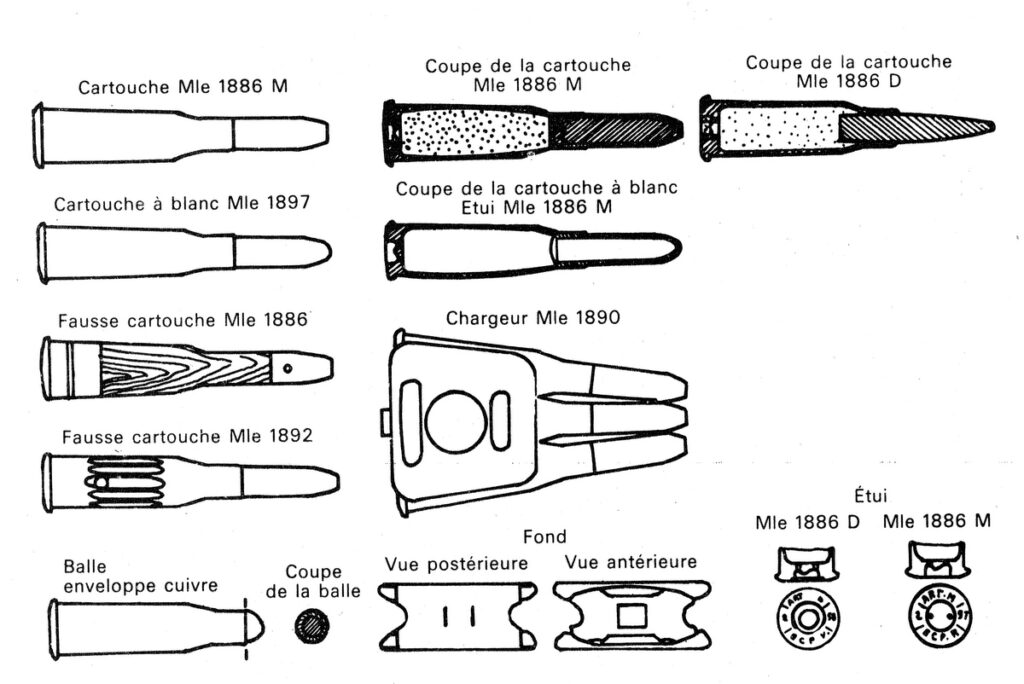
After WWI, a new round would be launched for the Lebel rifles still in service. Dubbed the “Balle N”, which was loaded with a steel-jacketed, Spitzer, boat-tail, lead bullet that had initially been designed for the Hotchkiss machine gun and required rifles to be rebored before they could safely fire it. The fact that rifles introduced back in 1886 were still around at the eve of World War II shouldn’t come as a surprise for the reader: the Lebel was, after all, a mighty solid rifle, although pushed into early obsolescence by the widespread adoption of smokeless powder cartridges by other countries.
PHASING OUT THE LEBEL
With most nations adopting rimless cartridge designs, quick reloading via detachable magazines and stripper clips became feasible and improved the volume of fire that an individual infantryman could provide at any given time. In 1906, the French military started to research a new service rifle that would replace the Lebel and give them the edge against their arch enemy, Germany, once again. Berthier bolt-action rifles were issued as a stop-gap measure to colonial troops, chambered in 8×50R Lebel and, later, in 7.5mm. But at the turn of the 20th Century, thus much before other countries, the French had their eyes already set on adopting a semi-automatic rifle. Tentatively, this had to be the Meunier A6, chambered in a powerful 7×59mm round, but the lengthy development process led to just about 1000 Meunier A6 rifles being manufactured before WWI broke out.
French troops thus found themselves fighting off advancing German armies for four years using a mishmash of Berthier 1892 rifles, a large quantity of Lebel Mle.1886 M93, and several tens of thousands of RSC M1917 and M1918 semi-automatic, gas-operated rifles chambered in 8×50R Lebel and designed to be assembled using numerous Lebel rifle components. The Lebel rifle could be equipped with a muzzle-mounted launcher for the VB Viven-Bessières rifle grenades, and it often was during the conflict. Accuracy of the rifle was deemed good enough that French snipers during WW1 were equipped with Lebel rifles supplied with two types of scopes – the APX Model 1916 and APX Model 1917, manufactured by the State-owned Atelier de Construction de Puteaux.
The retirement of the Lebel rifle was long postponed at the end of the “war to end all wars”, due to a lack of political interest in rearmament and the poor state of the French economy. Before, during, and after WWI quantities of the Lebel rifle were sold to Greece and Ethiopia, among others, as well as to the Republican side during the Spanish civil war. The MAS 1936 bolt-action rifle arrived too late, and the RSC 1917 and 1918 rifles were too scarce to fully replace it, and soldiers overall liked the high capacity of the old Lebel. A more advanced scope, the APX Model 1921, was developed for sniper-issued Lebel rifles and used up until the end of WWII, which saw French troops still fielding the old 1886 warhorse in very significant quantities.
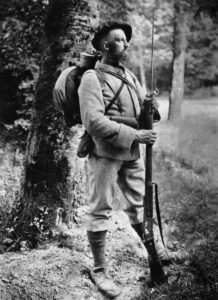
Meanwhile, newly manufactured, refurbished Lebel rifles, and carbines had found their way through mail order to French civilians, with Manufrance being the biggest distributor. The history of Manufrance commercial developments over the Lebel rifle warrants an article on its own, but in the inter-war period, a significant quantity of Lebel Mle.1886 M93 rifles were repurposed, refurbished, and converted into short carbines or mounted colonial troops in French Africa by Manufacture Nationale d’Armes de Tulle (“Tulle National Weapons Factory”) the French state-owned weapons manufacturer in the town of Tulle, Corrèze. These carbines, dubbed the Lebel Mle.1886 M93 R35, along with pre-existing Mle.1886 M93 rifles, saw use during WWII. They were captured by Axis powers and deployed by their rear line units during the last chaotic months of the war, ultimately ending its tour of duty in the French military when they were issued to local colonial auxiliary troops in Algeria and Indochina before being finally being completely replaced across the board by the MAS 49 and MAS 49/56 semi-automatic rifles. To this day, functional Lebel rifles can still be found in the hands of irregular militias in Africa and the Far East.
LEGACY OF THE LEBEL RIFLE
Nowadays, the Lebel Mle.1886 M93 rifle and M93 R35 carbine are appreciated collectibles among shooters in North America and Europe. Paradoxically, up until fairly recently, their motherland of France was the country where they were least easily available.

Until France implemented the 2008/51/EC European Firearms Directive in its national laws (which back then considered every firearm ever fielded by the French military or any other armed force in the world in the past century or so to be still a “military firearm”), the Lebel Mle.1886 rifle was considered a 1ére Categorie or “Category 1” firearm – essentially a “weapon of war”, like a machine-gun. Lebel rifles were thus often converted to calibers such as 348 Winchester for civilian sales in France. With such restrictions gone, now the original 8mm Lebel rifle in all its variants is considered a Catégorie C firearm in France, requiring registration of ownership, but no license for purchase or possession by anybody over the age of 16.
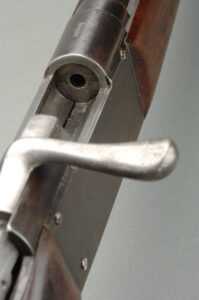
Interestingly enough, the Lebel name still lives on in modern French gun making, having been adopted by Verney-Carron, a well-known manufacturer of hunting and sporting firearms based in Saint-Étienne, as the new brand name for its line of riot control weapons and MIL/LE armaments. On November 8, 2023, Verney-Carron was contracted to deliver 10,000 assault rifles based on the M4 platform, 2000 designated marksman rifles based on the AR-10 design, and 400 40x46mm SR grenade launchers, all under the Lebel brand, to the armed forces of Ukraine. The contract is worth €36m, or just over US$39m at the current exchange rate. Deliveries will start in 2024.
| TECHNICAL SPECIFICATIONS | |
| Manufacturer | French Government arsenals in Tulle, Saint-Étienne and Châtellerault |
| Model | Fusil Lebel Modèle 1886 – Modèle 1886 M93 – Modèle 1886 M93 R35 |
| Type | Service rifle |
| Caliber | 8mm Lebel (8×50mm R) |
| Action | Bolt-Action |
| Safety | None |
| Capacity | 8-rd magazine tube + 1 on the elevator + 1 in chamber (Mle.1886, Mle.1886 M93) 3-rd magazine tube + 1 on the elevator + 1 in chamber (Mle.1886 M93 R35 carbine) |
| Sight systems | Fixed front post, adjustable rear ramp |
| Barrel length | 31.5 in. (Mle.1886, Mle.1886 M93) 17.7 in. (Mle.1886 M93 R35 carbine) 4 grooves, LH |
| Total length | 51.2 in. (Mle.1886, Mle.1886 M93) 37.8 in. (Mle.1886 M93 R35 carbine) |
| Weight (empty) | 9.35 lb. (Mle.1886, Mle.1886 M93) 8.28 lb. (Mle.1886 M93 R35 carbine) |
| Materials | Wood, Steel |



